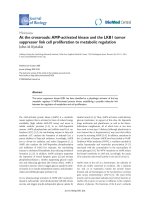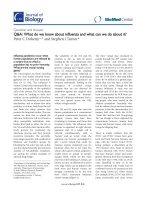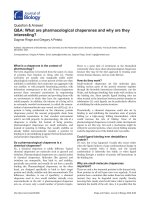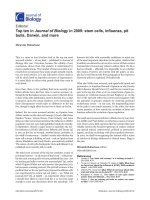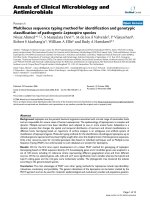Báo cáo sinh học: "Egg production albino hens to high and low light intensities during brooding-rearing" ppsx
Bạn đang xem bản rút gọn của tài liệu. Xem và tải ngay bản đầy đủ của tài liệu tại đây (412.53 KB, 7 trang )
Original
article
Egg
production
response
of
sex-linked
albino
(sa1
)
and
colored
(S)
hens
to
high
and
low
light
intensities
during
brooding-rearing
A
Bordas,
P
Mérat
Institut
National
de
la
Recherche
Agronomique,
Laboratoire
de
Génétique
Factorielle,
78352
Jouy-en-Josas,
cedex
fiance
(Received
6
September
1991;
accepted
22
January
1992)
Summary -
In
order
to
study
the
response
of albino
genotype
to
different
light
intensities,
sex-linked
albino
or
silver
female
chicks
hatched
from
heterozygous
sires
were
distributed
in
2
windowless
chick
rooms,
one
with
a
light
intensity
of
about
1
lux,
the
other
receiving
170
lux
on
average.
At
the
age
of
17
weeks
all
the
pullets
were
submitted
to
a
high
level
of
light
intensity
of
210
to
480
lux.
All
the
females
were
given
10
h
light
per
24
h
till
17
weeks,
then
14
h.
Age
at
first
egg
of
birds
receiving
high
light
intensity
as
chicks
was
14
d
earlier,
their
hen-day
production
was
slightly
superior,
and
their
mean
egg
weight
1.5
g
lower
as
compared
to
females
receiving
dim
light.
On
an
average,
the
albino
gene
depressed
initial
growth,
retarded
age
at
first
egg
by
5
d,
lowered
egg
weight
by
2
g,
increased
hen-day
production
by
5%,
and
lowered
the
frequency
of
pause
days.
With
low
light
intensity
during
brooding-rearing,
hen-day
production
of
the
albino
hens
was
7.5%
higher
than
that
of
colored
females
and
they
gave
12.8
eggs
more,
similarly
to
a
previous
experiment.
These
advantages
of
albinos
were
attenuated
with
high
light
intensity
in
the
juvenile
period.
However,
there
were
no
significant
genotype
x
treatment
interactions.
hen
/
sex-linked
albino
/
egg
production
/
light
intensity
R.ésumé -
Réponse
de
la
production
d’oeufs
de
poules
albinos
(s8l
)
et
colorées
(S)
à
l’intensité
lumineuse
en
poussinière.
En
vue
d’étudier
la
réponse
du
génotype
albinos
à
différentes
intensités
d’éclairement,
des
poussins
femelles
albinos
ou
argentés
(gène
lié
au
sexe)
issus
de
pères
hétérozygotes
ont
été
répartis
dans
2
poussinières
sans
fenêtres,
l’une
avec
une
intensité
lumineuse
d’environ
1 lux,
l’autre
recevant
en
moyenne
170
lux.
A
l’âge
de
17
semaines,
toutes
les
poulettes
étaient
soumises
à
une
forte
intensité
lumineuse,
de
!10
à
480
lux.
Toutes
les
femelles
étaient
éclairées
10
h
par
2.j
h
jusqu’à
17
semaines,
1,¢
h
ensuite.
L’âge
au
1er
oeuf
des
poulettes
ayant
reçu
une
forte
intensité
lumineuse
au
stade
juvénile
était
de
14 j
plus
précoce,
leur
intensité
de
ponte
était
légèrement
supérieure,
leur
poids
moyen
d’ceuf
de
1,5
g
plus
faible
par
comparaison
aux femelles
soumises
à
un
faible
éclairement.
En
moyenne,
le
gène
albinos
abaissait
légèrement
la
croissance
précoce,
retardait
l’âge
au
ler
oeuf
de
5
j,
réduisait
le
poids
de
l’a=uf
de
2
g,
augmentait
l’intensité
de
ponte
de
5%
et
diminuait
la
fréquence
des
jours
de
pause.
Avec la
plus
faible
intensité
lumineuse
en
poussinière,
l’intensité
de
ponte
des
poules
albinos
dépassait
de
7,5%
celle
des femelles
colorées
et
les
albinos
donnaient
12,8
ceufs
de
plus.
Ces
avantages
des
albinos
étaient
atténués
en
présence
d’une
forte
intensité
lumineuse
en
période
juvénile.
Il
n’y
avait
cependant
pas
d’interaction
significative
génotype
x
traitement.
poule
/
gène
lié
au
sexe
albino
/
intensité
lumineuse
/
production
d’oeufs
INTRODUCTION
In
a
previous
paper
(Merat
and
Bordas,
1989)
we
compared
egg
production
criteria
for
sex-linked
albino
(sal
)
or
colored
(S)
hens
of
the
same
origin
with
exposure
to
high
or
low
light
intensity
during
the
laying
period.
We
showed
that
the
albino
hens
were
slightly
inferior
to
the
non-albinos
with
exposure
to
the
lower
light
intensity
but
superior
to
those
with
exposure
to
the
higher
light
intensity.
Following
this,
we
wanted
to
reverify
the
results
obtained
at
high
light
intensity
and
further
to
examine
the
effects
of
lighting
level
during
the
brooding-rearing
period.
MATERIAL
AND
METHODS
Genotypes
Female
chicks
were
hatched
from
13
heterozygous
(S/s
al
)
sires
belonging
to
a
medium-heavy
brown-egg
type
line
maintained
segregating
for
the
alleles
s
al
(obtained
in
1979
from
RG
Somes,
University
of
Connecticut,
CT,
USA)
and
S
(silver).
The
albinism
allele
being
used
in
the
present
report
is
the
one
designated
by
Silversides
et
al
(in
press)
as
S’
l
-’.
These
males
were
pedigree
mated
to
60
hens
from
a
sex-linked
dwarf
brown-egg
type
line
selected
for
egg
production
traits
(Boichard,
1990,
personal
communication)
and
fixed
for
the
s+
(gold)
allele.
The
parents
utilized
were
similar
to
those
used
for
a
previous
experiment
!M6rat
and
Bordas,
1989).
About
half
the
female
progeny
of
this
cross
were
of
the
sa
genotype,
and
the
other
half
were
of
the
S
genotype.
In
total,
175
females
were
hatched
on
20/10/1989.
They
were
sexed
at
1
day-old
and
their
genotype
at
the
silver/gold
locus
was
determined
from
eye
color.
Experimental
conditions
The
chicks
were
raised
in
floor
pens
in
a
windowless
house
where
they
received
10
h
light
per
24
h.
Each
genotype
within
each
sire
family
was
distributed
equally
in
2
identical
rooms;
in
one
of
them
an
average
light
intensity
of
1.0
lux
at
the
height
of
the
birds
(0.5
to
2.0
lux
depending
on
measurement
location)
was
provided
by
incandescent
bulbs.
In
the
other,
3
additional
fluorescent
tubes
provided
a
mean
light
intensity
close
to 170
lux
(150
to
about
190
lux
according
to
measurement
location).
This
lighting
regimen
was
constant
until
17
weeks
of
age.
During
this
period
the
chicks
were
given
ad
libitum
a
mash
containing
180
g
crude
protein
and
11.7
MJ
metabolizable
energy
per
kg.
The
temperature
was
maintained
around
20°C
after
the
age
of
5
weeks.
At
the
age
of
17
weeks,
the
pullets
were
equally
distributed,
for
each
genotype
and
each
light
treatment
received
during
brooding-
rearing,
into
4
identical
rooms
each
containing
48
individual
cages
on
2
levels.
In
all
these
4
rooms
the
hens
received
ad
libitum
a
mash
containing
155
g
crude
protein,
34
g
calcium
and
11.05
MJ
metabolizable
energy
per
kg.
The
temperature
was
22°C
f
1°.
The
photoperiod
was
14
h
light
per
24
h.
The
lighting
intensity,
obtained
using
fluorescent
tubes,
was
uniformly
high,
corresponding
to
the
&dquo;high&dquo;
level
used
by
M6rat
and
Bordas
(1989).
Its
values
in
lux,
measured
in
each
room,
averaged
484
and
456
for
the
upper
cage
level
and
210
and
200
for
the lower
cage
level
at
the
beginning
and
at
the
end
of
the
experimental
period
respectively.
The
4
rooms
showed
very
similar
values.
Variables -
statistical
analyses
The
different
variables
appear
in
table
I.
The
egg
number
was
recorded
from
the
first
egg
laid
by
an
individual
hen
to
the
end
of
the
control
period,
ie
54
weeks
of
age.
Per
cent
shell-less,
double-yolked
or
cracked
eggs,
hen-day
percent
production,
mean
clutch
length,
and
percent
pause
days
(taken
as
at
least
2
consecutive
days
without
oviposition)
were
measured
over
the
same
period.
During
a
28-day
period
between
33
and
37
weeks
of
age,
after
the
peak
of
laying,
feed
intake
(0)
was
individually
recorded
together
with
egg
mass
(E),
body
weight
variation
(AW)
and
mean
body
weight
(W).
Two
derived
variables
were
feed
efficiency
(O/E)
and
the
residual
component
of
feed
intake
(R)
obtained
as
the
difference
between
0
and
a
predicted
intake
T
from
a
multiple
regression
equation
with
the
independent
variables
E,
W
and
AW
(Byerly
et
al,
1980).
The
equation
was
the
following:
The
mean
egg
weight
was
measured
from
a
2-week
collection
between
the
ages
of
35
and
37
weeks.
RESULTS
AND
DISCUSSION
.
Concerning
laying
hens
in
individual
cages,
no
effect
was
found
associated
with
the
level
of
the
cages,
in
spite
of
the
difference
of
light
intensity
mentioned
above,
and
accordingly
the
2
levels
have
been
pooled
in
the
following
analysis.
Table
I
gives
the
mean
values
per
genotype
and
lighting
treatment
and
the
statistical
significance
of
the
main
effects
and
their
interaction.
Figure
1
shows
the
laying
curves
for
each
experimental
group
till
the
end
of
the
experimental
period.
The
mortality
in
the
brooding-rearing
period
was
low
and
is
not
presented
in
detail.
The
mortality
from
the
age
of
17
weeks
till
the
end
of
the
recording
period
totalled
16
hens
(8.4%)
and
did
not
differ
significantly
either
between
treatments
or
between
genotypes.
The
numbers
of
dead
related
to
the
numbers
alive
at
17
weeks
age
were
respectively
7/47
and
3/48
for
colored
and
albino
females
at
high
light
intensity,
and
2/49
and
4/47
for
the
colored
and
albino
females
at
low
light
intensity.
Effects
associated
with
the
S
al
gene
Pooling
the
2
treatments,
the
albino
gene
was
associated
with
a
slight
depressing
effect
on
8-week
body
weight
(P
<
0.10);
a
similar
effect
was
not
significant
at
later
ages.
The
s’
l
layers
showed
on
average
a
5-day
retardation
of
’
the
age
at
first
egg,
and
5%
higher
hen-day
laying
percentage
than
S
females,
with
average
clutches
longer
by
1
day
and
fewer
pause
days.
As
a
consequence
the
number
of
eggs
from
s
al
layers
was
superior
(+
7.3),
but
on
the
whole
this
effect
was
not
significant.
The
mean
egg
weight
was
2.1
g
lower
for
the
albino
than
for
the
colored
hens.
A
slight
reduction
of
body
weight
and
mean
egg
weight
was
found
associated
with
the
s
al
gene
by
M6rat
et
at
(1986)
and
Silversides
and
Crawford
(1990a,
b).
A
delay
for
the
sexual
maturity
of
albino
females,
comparable
to
that
found
in
the
present
work,
was
mentioned
by
M6rat
et
at
(1986)
and
Silversides
and
Crawford
(1990b).
M6rat
and
Bordas
(1989)
did
not
find
this
relationship,
not
did
they
find
a
genotype
effect
on
egg
weight.
On
the
other
hand,
the
present
results
agree
with
those of
M6rat
and
Bordas
(1989)
concerning
the
absence
of
any
effect
associated
with
the
s
al
allele
on
eggshell
strength
and
feed
efficiency.
However,
in
both
studies
the
percentage
of
cracked
eggs
was
slightly
higher
for
albino
hens.
In
both
studies
also,
the
body
weight
gain
of
adult
hens
in
a
28-d
period
was
slightly
superior
for
albino
females,
possibly
as
a
late
compensation
for
the
small
initial
growth
retardation.
In
interpreting
the
differences
concerning
egg
production
traits,
it
is
interesting
to
compare
the
present
results
with
those
of
M6rat
and
Bordas
(1989),
in
spite
of
the
absence
of
statistically
significant
genotype
x
treatment
interactions
shown
in
table
I.
From
this
table
it
is
seen
that
for
hen-day
laying
percentage
and
mean
clutch
length,
the
advantage
of
the
s
al
over
the
S
hens
is
7.5%
and
1
day
respectively,
the
percentage
of
pause
days
of
the
former
is
7.3%
less,
and
they
lay
12.8
eggs
more
in
the
environment
characterized
by
low
light
intensity
in
the
brooding-rearing
house.
A
t-test
between
the
mean
of
the
albino
and
that of
colored
hens
within
this
environment
is
significant
at
the
1%
and
5%
level
for
hen-day
laying
rate
and
egg
number
respectively.
This
lighting
treatment
was
the
same
(low
light
intensity
before
17
weeks,
high
intensity
afterwards)
as
the
one
called
&dquo;high
intensity
group&dquo;
in
the
report
by
M6rat
and
Bordas
(1989).
M6rat
and
Bordas
(1989)
found
that
the
superiority
of
the
albino
hens
over
the
colored
ones
was
9.4%
for
hen-day
laying
rate,
2.7
days
for
mean
clutch
length,
and
19.1
eggs.
These
differences
seem
reasonably
similar
in
the
2
experiments.
In
the
present
work,
the
same
differences,
although
being
in
the
same
direction,
are
numerically
less
in
the
group
receiving
the
higher
light
intensity
in
the
rearing
period:
2.3%
for
hen-day
percent
production
and
only
1.7
more
eggs
produced
by
the
s
al
hens.
Effect
of light
intensity
Irrespective
of
the
genotype,
the
lighting
intensity
received
until
the
age
of
17
weeks
has
several
highly
significant
effects.
The
brighter
light
increases
the
8-week
weight
by
about
30
g,
it
hastens
by
14
days
the
mean
age
at
first
egg,
and
seems
to
slightly
increase
(+3.2%)
the
hen-day
laying
rate,
so
that
19
more
eggs
are
obtained
with,
this
treatment.
Other
effects,
generally
associated
with
an
earlier
sexual
maturity,
are
a
lower
average
egg
weight
(-1.5
g),
an
increased
percentage
of
shell-less
and
double-yolked
eggs,
and
a
reduced
body
weight
gain
of
adult
hens.
The
adult
body
weight
shows
a
non-significant
100
g
reduction,
and
feed
efficiency
and
percent
cracked
eggs
are
not
affected.
In
total,
the
more
intense
light
at
the
juvenile
stage
is
superior
for
egg
production,
with
a
slight
advantage
of
the
s
al
genotype
suggested
in
this
environment.
The
stimulating
effect
on
sexual
maturity,
found
here
to
be
associated
with
a
high
light
intensity
given
to
young
chicks,
was
not
found
in
earlier
works.
Sauveur
(1988)
mentions
that
the
range
of
1
to
5
lux
applied
during
the
growing
period
has
no
effect
on
laying.
Skoglund
et
al
(1975),
with
intensities
of
5
to
more
than
50
lux
and
Morris
et
al
(1988),
with
mean
intensities
of
2
and
10
lux
observed
no
advantage
for
egg
production
associated
with
brighter
light,
but
their
treatments
mainly
concerned
the
egg
laying
period.
Brake
(1988,
1989)
compared
the
effect
of
8
h
light
provided
by
incandescent
bulbs
(20
lux)
or
daylight
(800
lux)
on
subsequent
egg
production,
the
former
group
showed
an
advantage
or
not
depending
on
the
season.
The
apparent
discrepancy
between
our
results
and
those
of
others
may
be
due
to
the
fact
that
we
gave
10
h
lighting
per
day
in
the
brooding-rearing
house
instead
of
the
8
h
more
usually
provided,
so
that
with
this
longer
daily
illumination
the
light
intensity
may
have
become
more
stimulating.
Among
other
possible
differences
is
the
wider
range
of
our
light
intensities
in
comparison
with
the
usually
low
values
recommended
for
practical
purposes
(North,
1984).
Anyway
our
aim
was
not
to
study
the
effects
of
light
per
se,
but
to
investigate
the
specific
response
of
albino
birds
to
this
environmental
factor,
including
a
comparison
with
a
former
experiment
which
conditioned
the
choice
of
lighting
treatments.
In
conclusion,
this
work
agrees
with
a
previous
study
(Mérat
and
Bordas,
1989)
as
regards
an
advantage
of
albino
hens
for
egg
production
traits
when
they
are
given
dim
light
as
juveniles
and
bright
light
during
the
egg
production
period.
This
advantage
is
lowered
if the
light
intensity
during
the
growth
period
is
higher.
On
the
other
hand,
owing
to
stimulation
of
sexual
maturity
by
a
more
intense
light
up
to
17
weeks
of
age,
irrespective
of
the
genotype
at
the
S
locus,
under
our
conditions
the
subgroup
which
showed
the
best
laying
performance
was
represented
by
the
albino
hens
receiving
a
high
light
intensity
both
before
and
after
the
age
17
weeks.
REFERENCES
Brake
JT
(1988)
The
role
of
lighting
programmes
in
broiler
breeder
management.
18th
World
Poult
Congr,
Nagoya,
Symposia,
171-175
Brake
JT
(1989)
Effect
of
light
source
during
rearing.
Poultry
5,
11-13
Byerly
TC,
Kessler
JW,
Gous
RM,
Thomas
OP
(1980)
Feed
requirements
for
egg
production.
Poult
Sci
59,
2500-2507
M6rat
P,
Bordas
A
(1989)
Differential
response
of
sex-linked
albino
(sal
)
and
silver
(S)
hens
to
high
and
low
light
intensity.
Br
Poult
Sci
30,
807-813
M6rat
P,
Bordas
A,
Coquerelle
G
(1986)
Caract6ristiques
de
croissance,
ponte
et
efficacit6
alimentaire
associ6es
au
gene
s
al
(albinos
lie
au
sexe)
chez
la
poule
domestique.
Genet
Sel
Evol 18,
343-350
Morris
TR,
Midgley
M,
Butler
EA
(1988)
Experiments
with
the
Cornell
intermittent
lighting
system
for
laying
hens. Br
Poult
Sci
29,
325-332
North
MO
(1984)
Commercial
Chicken
Production
Manual.
Avi
Publ
Co,
Westport,
USA,
3rd
edn,
p
330
Sauveur
B
(1988)
Reproduction
des
Uolailles
et
Production
d’!ufs.
INRA,
Paris,
114-123
Silversides
FG,
Crawford
RD
(1990a)
Effect
of
sex-linked
imperfect
albinism
(S
al
on
growth
in
a
heavy
line
of
chickens.
Poult
Sci
70,
6-12
2
Silversides
FG,
Crawford
RD
(1990b)
Effect
of
imperfect
albinism
(sal
-S)
on
egg
production
in
two
lines
of
chicken.
Poult
Sci
70,
702-708
Silversides
FG,
Mérat
P,
Coquerelle
G
(1992)
Differential
environmental
effects
of
lesions,
early
growth
and
mortality
on
imperfect
albino
(S
a
’-
c)
chicks.
Poult
Sci
(in
press)
Skoglund
WC,
Palmer
DH,
Wabeck
CI,
Verderis
JN
(1975)
Light
intensity
required
for
maximum
egg
production
in
hens.
Poult
Sci
54,
1375-1377

